Lately, the phrase “We use agile software development methodology” is everywhere, especially for web and mobile app development projects. In fact, according to GoodFirms Research, it was found that Agile is the aptest software development method. But what does it mean?
Keeping the word “agile” aside, software development methodology refers to the predefined approach or strategy that illustrates the route to be followed by the software development team. It is essential for successful project delivery and deployment of the product.
So it can be said that the software development methodology can pretty much make or break the final product. Hence choosing the right system development methodology is vital for the development of the end product.
Table of contents:
What are the phases of SDLC? Why is software development methodology important? How to choose the right software development methodology? What Are the Key Factors to Determine the Right Methodology for Any Given Software Project/SDLC Method? 6 Software development methodologies comparison
1. Waterfall Model
2. Prototype Model
3. The Iterative Model
4. Spiral Model
5. RAD Model
6. Agile Model
What are the phases of SDLC?
The Software Development Life Cycle (SDLC) clearly outlines each and every task that is needed to develop a web or mobile application.
Now, this whole process helps in minimizing unnecessary, time-consuming tasks and improves the efficiency of the application development process.
In a typical SDLC, there are seven phases.
- Planning
- Defining requirements
- Designing and prototyping
- Application development
- Testing
- Deployment
- Support and maintenance
Why is software development methodology important?
The software development methodology is often overlooked and underestimated part of the application development process.
Instead of choosing the suitable methodology that perfectly fits the project at hand, some product developers focus on other aspects that lead to delayed deliveries, dissatisfied customers, and a big whole recipe for disaster.
The most suitable software development methodology provides a consistent structure and approach to the project development.
By standardizing the strategy and the steps to transform an idea into a fully-functional software, your business can have an edge over the competitors.
A few benefits of software development methodology are:
- No major change in project costs
- Software developers follow the written schedule and easily meet the deadlines
- Reduced frequent discussions that add no value to the project
- Everyone stays on the same page– developers, company, and client
How to choose the right software development methodology?
To start with, there are six software development methodologies that are currently in use and they are:
- Waterfall Model
- Prototype Model
- The Iterative Model
- Spiral Model
- RAD Model
- Agile Model
Now, can we just choose any one of the models?
Of course, not.
The value of the software development methodologies lies in process optimization. Every model is different in its own way. Each software development methodology is best suited to certain types of software projects based on objectives, goals to achieve, and other factors.
Hire on-demand dedicated software developers of desired skill & experience.
What Are the Key Factors to Determine the Right Methodology for Any Given Software Project/SDLC Method?
- Identify the level of flexibility in the software requirements
- Know the end-users
- Assessing the project size
- Finding out the development speed that best suits the project
- Considering the time-zone difference, if the offshore development team
- Get the best developers on board
Let’s take a look at 6 Software development methodologies and their comparison.
6 Software development methodologies comparison
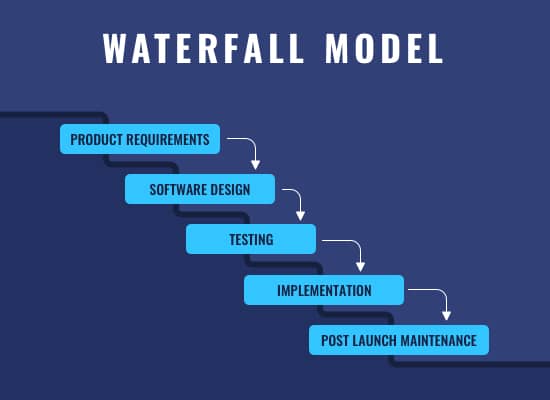
1. Waterfall Model
Waterfall software development methodology is one of the oldest and widely used methods for the product creation process.
The term “Waterfall” refers to a development model that has clear-cut sequential phases and objectives. In this method, it is required of developers to complete the current phase or work-in-progress before moving on to the next stage.
Advantages of Waterfall Model
- Easy to understand & Great for beginners
- Effortlessly manageable
- Individual review process for each and every phase for easy task management
- Deliverables are clearly identified
- Ease of process makes testing and analysis simpler
Disadvantages of Waterfall Model
- No client feedback available during the initial stages
- Upfront requirements are required to use this method
- Not ideal for long or ongoing projects
- Issues are often not identified until system testing
- Not feasible to go back and make changes once the product is in the testing phase
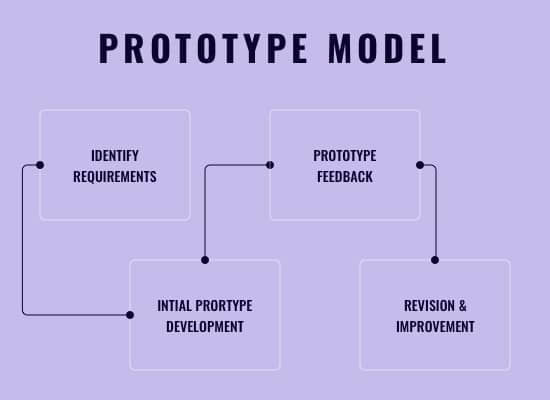
2. Prototype Model
As you have guessed, the Prototype model refers to the process of creating prototypes of software, in other words, these prototypes are the incomplete versions of the software that is being developed.
Now, the motive behind creating incomplete prototypes is that the client can get a visual representation of the product using minimal features. This gives a better understanding of client requirements in the early development stages as the developers get valuable feedback from the client.
Advantages of Prototype Model
- Client involvement right from the early stages of product development
- Sample working model of the software will be provided to the users for the betterment of the product
- Minimizes cost and development time due to early defect identification
- Quick user feedback makes the process much faster
- Missing requirements in the functionality or feature are easily identifiable
Disadvantages of Prototype Model
- Insufficient analysis of requirement due to over dependency on the prototype
- Unfamiliar users with prototypes can confuse sample models with complete system
- The process has to be monitored for building an effective prototype
- Requirements may change frequently than expected
- Documenting non-functional elements is complicated
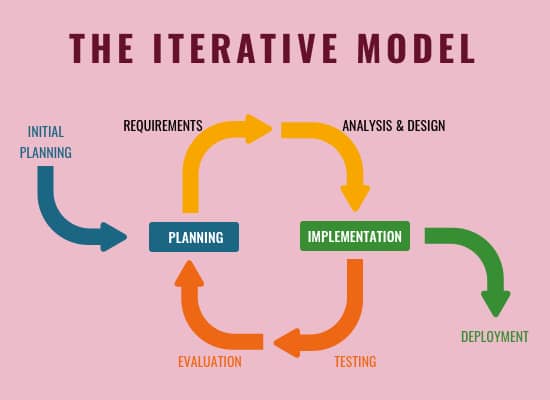
3. The Iterative Model
Also known as the Incremental Software Development Method, this methodology applies to products that are developed on an incremental basis.
The process begins with a half-done software product and then developers will keep integrating more features and functionalities into the software until the software is fully complete.
Advantages of Iterative Model
- Results are achieved in cycles
- Enables an easy project progress
- Requirements can be effortlessly changed
- Minimum time to test and debug if the interactions are small
- Ideal for complex projects
- Reduces initial time for production
- Allows for parallel deployment
Disadvantages of Iterative Model
- Takes more management as there will be more iterations
- Not ideal for small-size projects
- Risk analysis is required from skilled resources
- Too much dependency on risk analysis
Hire dedicated software development team for your next project.
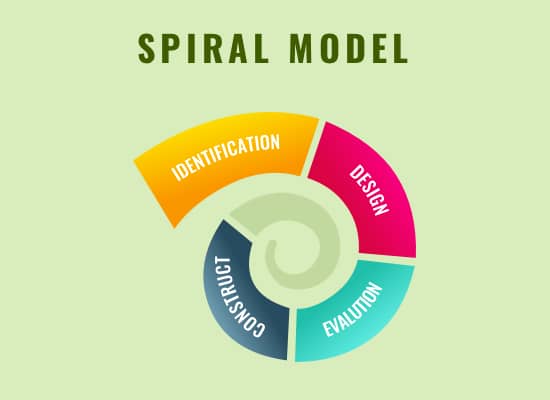
4. Spiral Model
A classic combination of Iterative and Waterfall methodologies, Spiral Model includes a few key aspects of both models. This particular model provides emphasis on risk assessment and reducing project risk by breaking the project into small, easily achievable targets.
Advantages of Spiral Model
- Focuses more on risk avoidance
- Ideal for large and complex enterprise level software development that require prototyping and analysis frequently
- Accurate understanding of requirements
- Enables end-users to view the product in the early stages
- Usage of prototypes is extensive
Disadvantages of Spiral Model
- Not easy to manage and maintain
- Not ideal for small or low-risk projects
- Development costs can be expensive when utilized for small projects
- Numerous intermediate stages are needed to be documented
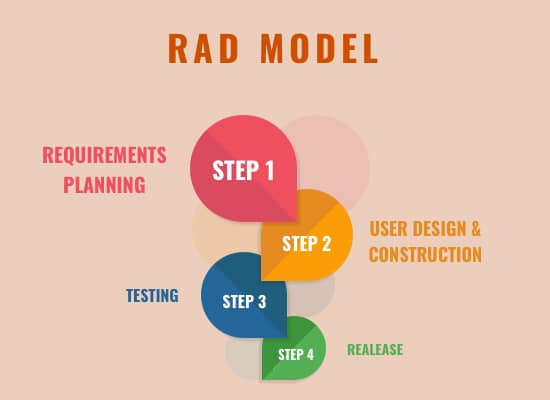
5. RAD Model
Stands for Rapid Application Development, RAD model offers swift and high-quality results. The primary objective behind using this model is to accelerate the process of product development via active user participation.
This model partially favours Iterative development and the rapid development of prototypes when compared to up-front planning.
Advantages of RAD Model
- Enables early detection of issues
- Feedback from users after testing and interacting with the prototypes
- Saves development time, thanks to less planning and documentation
- Frequent client feedback minimizes poor execution
Disadvantages of RAD Model
- New method compared to other existing methods
- Not ideal for small projects due to modellig cost and automated code generation
- Demands a well-versed and highly experienced team due to the fast-moving nature of the methodology
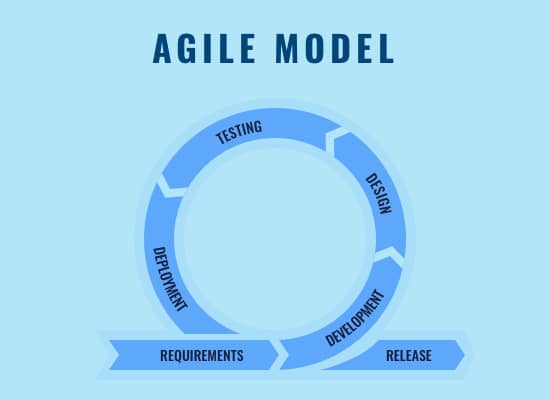
6. Agile Model
Agile is one of the most common and widely-used methodologies across the globe. This model breaks down the project development into smaller, easily attainable and manageable development cycles known as iterations.
Very much similar to the Iterative model, the major difference between both is that progress can be seen much more quickly in the Agile method. It expedites the development process from months to just a few weeks. Agile is further divided into several methods, each has its own principles.
For example, Scrum Software Development Methodology, Lean Software Development Methodology, and Extreme Programming are some of the few.
Advantages of Agile Model
- Improves collaboration and flexibility in the product development process
- Offers versatility for custom software development services with particular needs
- Enables transparency between the development team and client
- Identifies issues and defects quickly
- Realistic approach
- Swift feedback from client reduces the guesswork
- Ideal for both fixed and changing scope of work projects
Disadvantages of Agile Model
- Demands an experienced Project Manager for the job
- Lack of documentation may lead to functional issues
- Over dependency on collaboration and interaction with end-users
- Cannot handle complicated dependencies
What is the most popular software development methodology?
Agile (SCRUM) and Waterfall methods are the most used software development methodologies. According to a report that was published by CollabNet VersionOne, a 71% increase in project cost reduction is why more and more companies are turning to the Agile method, precisely, 61.5% of development teams choose the Agile method when choosing their software development methodology..
Coming to the Waterfall method, some say it is less effective than Agile, while some say it is equally good. Having said that, any methodology’s success rate depends on the type of project it is being applied to.
Which methodology is best for software development?
There is no one simple answer to this question. The methodology you choose will depend on the type of project, development costs, flexibility, and many such factors. For example research shows that startup software applications prefer agile software development methodology. You cannot choose a methodology simply because every software development company or developer is using it or it is trendy.
On the contrary, if you pick the wrong methodology, you could jeopardize the whole project. Each methodology comes with its own merits and demerits. Sit with the software development team and decide carefully what’s right for your project.





